Home / Some Reactions of Azides
Amines
Some Reactions of Azides
Last updated: September 21st, 2022 |
Azide Ion: Structure, Properties, and Substitution Reactions

Table of Contents
- The Azide Ion Is A Great Nucleophile
- Organic Azides As “Masked” Amines
- Exploding On The Launchpad
- Nucleophilic Acyl Substitution With Azide Salts: Acyl Azides
- Rearrangement of Acyl Azides: The Curtius Rearrangement
- More Examples of Azide Nucleophiles: Epoxide Opening And Conjugate Addition
- Notes
- (Advanced) References and Further Reading
1. The Azide Ion Is A Great Nucleophile In SN2 Reactions
The azide ion (N3– ) is one of those chemical entities that just plain looks weird.

- Three nitrogens in a row? check
- Two negative charges and a positive charge, for a net charge of –1 ? check
- Stable? check (as long as it’s treated gently).
As it turns out, the azide ion can extremely useful for forming C-N bonds in nucleophilic substitution reactions.
The azide ion is the conjugate base of hydrazoic acid, HN3. Despite being only weakly basic (the pKa of HN3 is only 4.6) N3 is an extremely good nucleophile – according to one measure, more nucleophilic than any amine (see post: Nucleophilicity of amines). It’s not hard to rationalize why this might be when you stop to think about it. With four nucleophilic lone pairs confined to a very small volume, the likelihood of a collision with an electrophile that results in a reaction is much higher than it would be for an amine with bulky alkyl groups, to take just one example.
You can think of N3– as a lean, mean, nitrogen-tipped missile that delivers its payload onto carbon quickly, efficiently, and without significant side reactions.
In SN2 reactions, primary and secondary alkyl halides and sulfonates are readily displaced by N3– , resulting in alkyl azides:
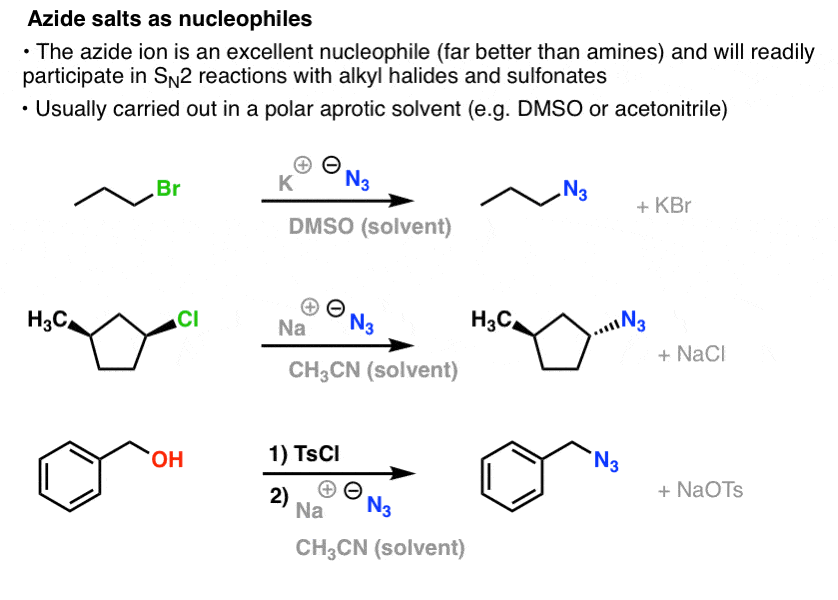
The usual procedure is to use an azide salt such as NaN3 or KN3 with the appropriate alkyl halide in a polar aprotic solvent such as acetonitrile (CH3CN) or dimethylsulfoxide (DMSO).
The organic azide products are reasonably stable, even if they look a little weird. Some have even found use as pharmaceuticals (e.g. AZT, below right) or as useful probes for studying chemical biology. [Note 1].
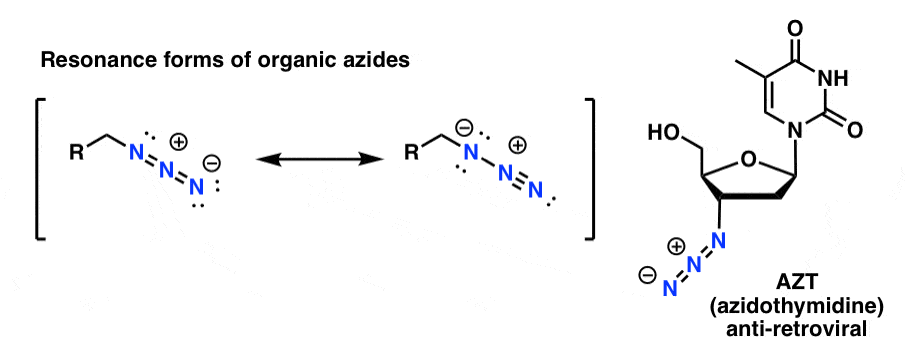
For our purposes the most useful property of organic azides is that they serve as “masked” amines.
2. Organic Azides as “Masked Amines”
Note the resonance form above with a nitrogen-nitrogen triple bond. If treated with a reducing agent, such as LiAlH4 or even catalytic hydrogenation (Pd/C , H2) organic azides can be reduced to primary amines, liberating N2 in the process.
This makes for a very useful route to primary amines from alkyl halides!

We’ve previously explored the Gabriel synthesis as a route to primary amines [see post: The Gabriel Synthesis], but this route is superior because the azide can be reduced to the amine under gentle conditions (e.g. hydrogenation). None of that high-temperature cleavage of the phthalimide with hydrazine to worry about.
We also saw that making primary amines through direct treatment of alkyl halides with NH3 often doesn’t result in the desired product, because of amines have a Cookie-Monster-like tendency to react multiple times with alkyl halides: since the amine products tend to be more nucleophilic than the reactants, it’s hard to get amines to stop at munching just one alkyl halide. [see post: Alkylation of Amines]
[Note 2 – primary amine synthesis “do’s and don’ts” graphic]
3. Exploding On The Launchpad
If N3 is a “nitrogen-tipped missile”, as we commented above, it’s worth recalling what happens when a missile isn’t handled with care: it’s essentially a bomb.
NaN3 and KN3 are white powders that can be stored indefinitely at room temperature and scooped out at the bench without any trouble.
But when heated or subjected to shock – all bets are off. The same goes for exposure of these azide salts to acid, which forms potentially explosive HN3.
And NaN3 and KN3 are the nice azides! If mixed with metal salts of lead, mercury, cadmium, zinc, or silver, even more explosive azide compounds can result. These metal azides are contact explosives, some of which are so sensitive that they will detonate if someone farts twenty feet down the hall. Some crazy chemists even make these things on purpose, but we will not be travelling anywhere near the blast radius of that topic on this blog anytime, ever.
NaN3 and KN3 should be used at reasonably dilute concentrations, behind a blast shield on preparative scale, and incidentally never used with CH2Cl2 solvent, which can result in highly explosive diazidomethane.
Now, there are times when a sudden blast of nitrogen gas is useful – and potentially life-saving. You may have already spent a portion of your day in close proximity to sodium azide without even realizing it. That’s because NaN3 is one of several propellants that finds use in airbags; once triggered by an accelerometer, detonation of NaN3 expels N2 gas at over 200 mph, inflating the bag in 1/25 of a second. [Note 3]
Yay for azide salts!
(But don’t be this guy):
Bottom line: SN2 reactions between alkyl halides or sulfonates with azides are probably the single best way to synthesize primary amines from alkyl halides. It certainly beats the Gabriel synthesis.
4. Nucleophilic Acyl Substitution With Azide Salts Makes Acyl Azides
The SN2 reaction isn’t the only type of substitution reaction we’ve explored. There’s also nucleophilic acyl substitution. A carbonyl attached to a good leaving group (such as an acid chloride or anhydride) will undergo substitution when an appropriate nucleophile is added.
In the first step of the mechanism, the nucleophile (Nu) attacks the carbonyl carbon, forming C-Nu and breaking C-O (pi). This gives rise to a tetrahedral intermediate. In the second step, the C-O pi bond is re-formed, and the carbon-(leaving group) bond is broken, resulting in the nucleophilic acyl substitution product.
Here is an example of a nucleophilic acyl substitution reaction between an acid chloride and the N3 ion to give an acyl azide:
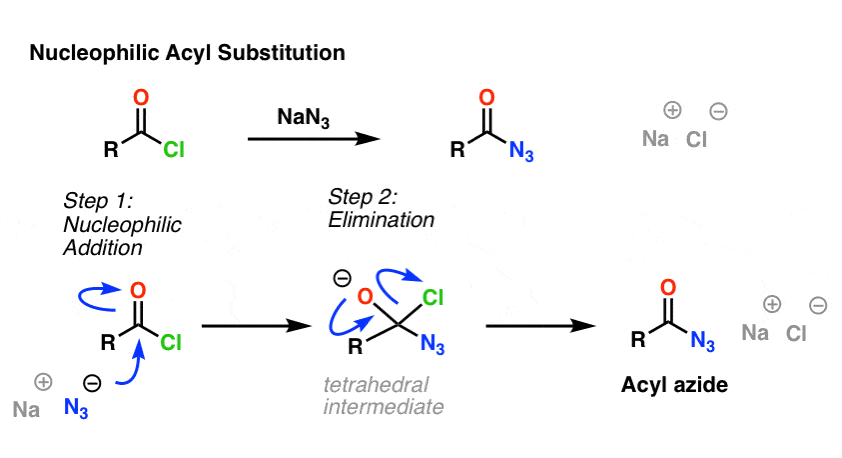
5. Rearrangement of Acyl Azides: The Curtius Rearrangement
The most common use for acyl azides is that upon heating, they rearrange to give isocyanates in a reaction known as the Curtius rearrangement. [see post: The Hofmann and Curtius Rearrangements]
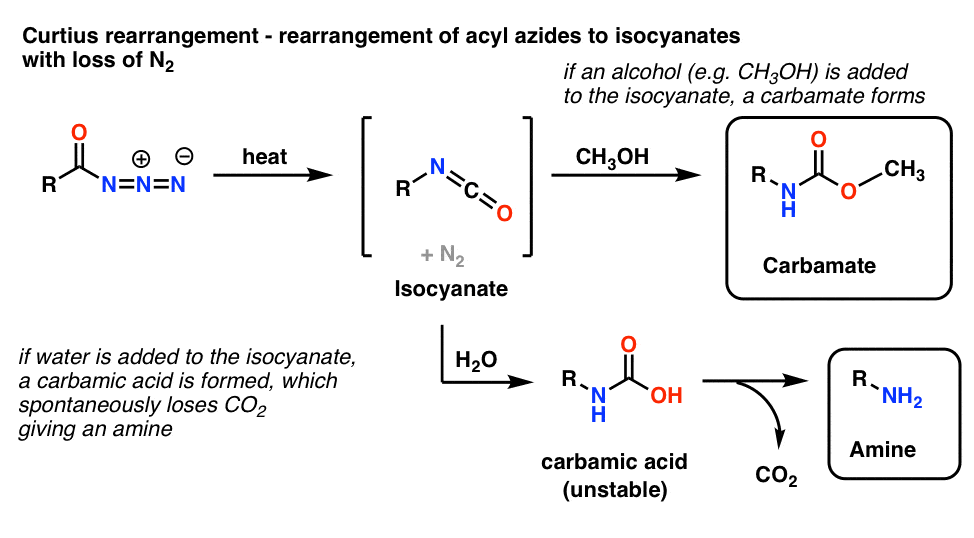
- If the Curtius is performed in the presence of an alcohol such as methanol, a carbamate is formed.
- If water is added instead, an unstable carbamic acid is briefly formed, which then loses carbon dioxide to give a primary amine.
Why might this be useful? Here’s one way.
There are a lot of methods for making aromatic carboxylic acids, but not so many great ways of forming C-N bonds on aromatic rings. Say you have a benzoic acid (such as p-methylbenzoic acid) but need to form a (protected) aromatic amine. The Curtius protocol represents a nice way of forming a new C-N bond on the ring without having to resort to nitration + reduction.
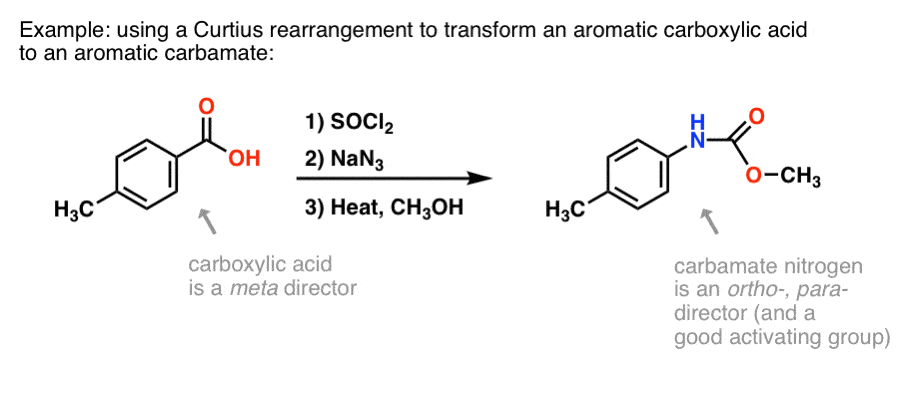
(In this way it’s somewhat analogous to an nitrogen equivalent of the Baeyer-Villiger oxidation. )
6. More Examples Of Azide Nucleophiles: Epoxide Opening And Conjugate Addition
Two more applications of the azide ion as a nucleophile include the opening epoxides (in what is essentially an SN2 process – note the inversion of configuration) and also conjugate addition on alpha,beta unsaturated ketones:

The resulting alkyl azides can then be reduced to primary amines using the methods covered above.
Notes
Related Articles
- The Hofmann Elimination
- The Hofmann and Curtius Rearrangements
- More Reactions on the Aromatic Sidechain: Reduction of Nitro Groups and the Baeyer Villiger
- The SN2 Mechanism
- Nucleophilicity of Amines
- Alkylation of Amines (Sucks!)
- The Gabriel Synthesis
- SN2 reaction between azide ion and alkyl halides to give alkyl azides (MOC Reaction Guide)
- Amine Practice Questions (MOC Membership)
Note 1.Azide-Alkyne Cycloadditions, a.k.a. “Click” chemistry
An interesting and useful application of organic azides that hasn’t yet made it into introductory organic chemistry textbooks (but likely will in the near future) is a process technically called the “copper-catalyzed azide-alkyne cycloaddition“, but more commonly just called the “alkyne-azide click reaction”.
When a terminal alkyne is treated with a copper catalyst in the presence of an organic azide, a cycloaddition rapidly results, leading to the formation of a 1,2,3-triazole.
We won’t go deep into the details, but this ring-forming reaction involves 6 pi electrons and is a cousin of the Diels-Alder reaction (nitpckers will rightly note that the copper-catalyzed version isn’t technically a concerted process, but the non-catalyzed version is)
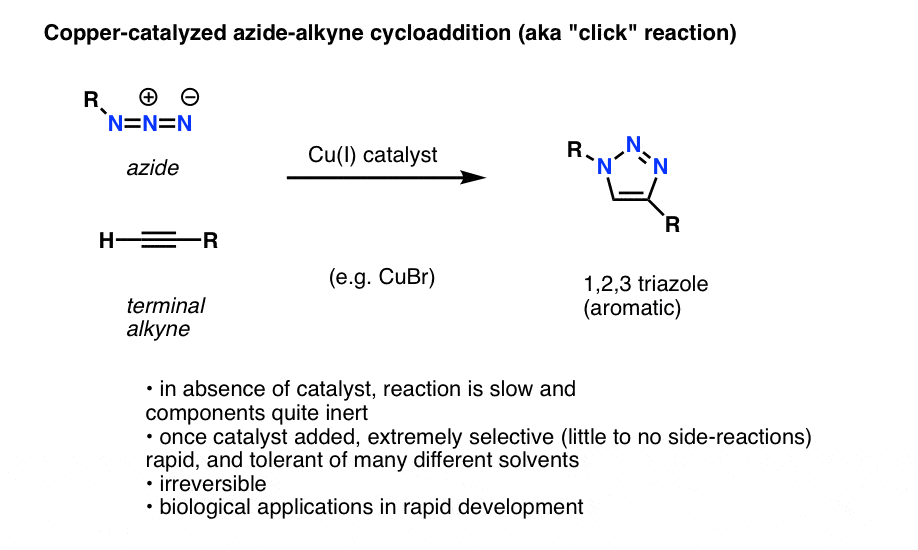
The reaction is notable for a few reasons:
- the reactive partners (terminal alkyne and organic azide) are relatively inert in the absence of a catalyst under most conditions.
- once copper is added, reaction occurs extremely rapidly under mild conditions and in a variety of solvents (including water).
- it’s extremely selective under these conditions,the alkyne and azide partners react only with each other, irreversibly.
- the product, a triazole ring, is aromatic and stable
It’s been called a “click” reaction by one of its originators, Barry Sharpless, because it’s one of the closest things chemists have to a reaction that is like the smooth “clicking together” of two complimentary lego blocks.
What has made this reaction particularly useful of late is that azide and alkyne partners can be installed in molecules of biological interest, and “clicked” together when desired.
For instance:
- Putting an acetylene at the 5′ position of a sugar and an azide at the 3′ position has been used to make “clicked” DNA, where the triazole replaces the organophosphate. [link]
- Incredibly, one group has made “clicked” DNA, put it into human cells, and managed to get it transcribed by messenger RNA. [link]
- azide-containing AZT (above) works by gumming up the transcription machinery. Some clever folks found a way to apply the azide-alkyne click reaction toward rapid genome sequencing, a technique known as ClickSeq. [a very readable account here, courtesy of In The Pipeline]
,Note 2. Primary amine synthesis “Do’s and Don’ts” :
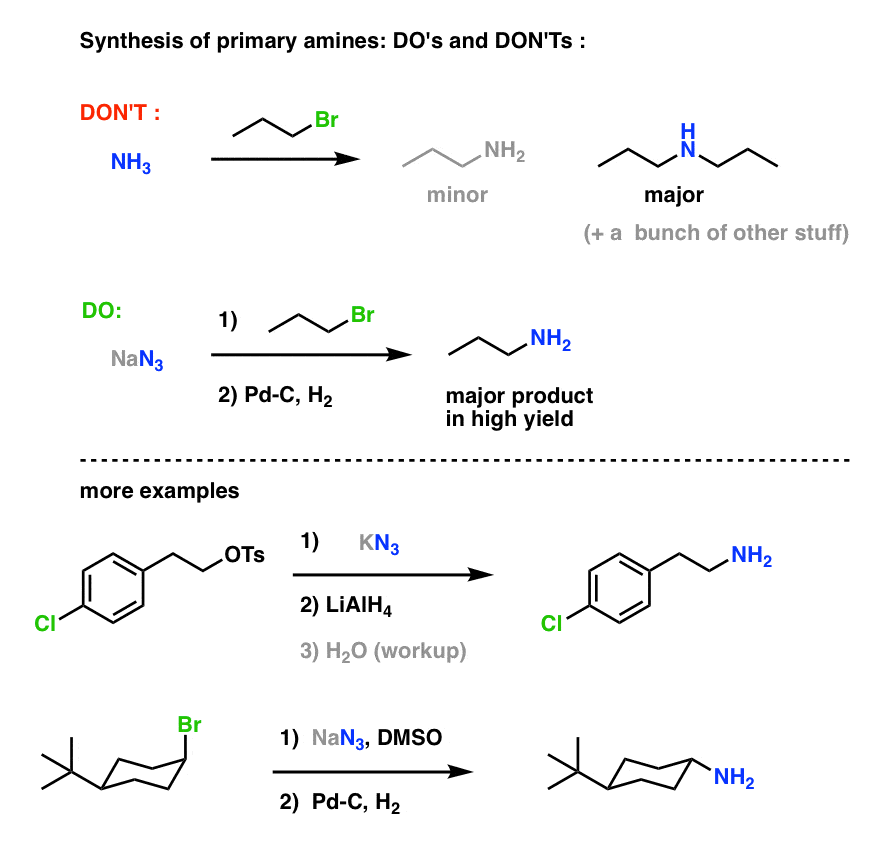
Note 3. Takata used sodium azide in the early 1990’s, and then moved to tetrazole and then ammonium nitrate.
From “Sixty Million Car Bombs: Inside Takata’s Air Bag Crisis“.
Ammonium nitrate was about one-tenth the price of tetrazole, according to Upham, who also reviewed industry patents. But ammonium nitrate had a critical flaw that he says led other air bag makers to give up on it: Ammonium nitrate has five phases of varying density that make it hard to keep stable over time. A propellant made with ammonium nitrate would swell and shrink with temperature changes, and eventually the tablet would break down into powder. Water and humidity would speed the process. Powder burns more quickly than a tablet, so an air bag whose propellant had crumbled would be likely to deploy too aggressively. The controlled explosion would be just an explosion. “Everybody went down a certain road, and only Takata went down another road,” says Jochen Siebert, who’s followed the air bag industry since the 1990s and is now managing director of JSC Automotive Consulting. “If you read the conference papers from back then, you can actually see that people said, ‘No, you shouldn’t. It’s dangerous.’ ”
Shrapnel from the faulty airbags has killed 13 people worldwide, and injured more than 100.
On June 25, 2017, facing liabilities of over $11 billion dollars, Takata filed for bankruptcy.
(Advanced) References and Further Reading
Azides are useful in organic synthesis, and a highlight of azide chemistry is given in the references below.
- Nucleophilic reactivity of the azide ion in various solvents
Thanh Binh Phan, Herbert Mayr
Phys. Org. Chem. 2006, 19 (11), 706-713
DOI: 10.1002/poc.1063
Prof. Herbert Mayr (LMU, Munich, Germany) has spent his career contributing to fundamental physical organic chemistry by quantifying electrophilicity and nucleophilicity, and developing scales for comparing the reactivity of various nucleophiles and electrophiles. - The SN2 displacements at 2-norbornyl brosylates
Klaus Banert and Wolfgang Kirmse
Journal of the American Chemical Society 1982, 104 (13), 3766-3767
DOI: 1021/ja00377a057 - An Improved Synthesis of Azidothymidine
I. Balagopala, A. P. Ollapally, & H. J. Lee
Nucleosides, Nucleotides & Nucleic Acids 1996, 4, 899-906
DOI: 10.1080/07328319608002136
Azides can be used as nucleophiles in SN2 reactions. Ref. #3 shows the use of azide ion in the synthesis of AZT (azidothymidine). The conversion of 1 to 5 via 3 in ref. #3 uses the Mitsunobu Reaction, which allows displacement of an -OH group with a nucleophile with inversion of configuration. - Reduction of Organic Azides to Primary Amines with Lithium Aluminum Hydride
H. Boyer
Journal of the American Chemical Society 1951, 73 (12), 5865-5866
DOI: 10.1021/ja01156a507
The reduction of organic azides to primary amines is a convenient method for the synthesis of primary amines, which are otherwise difficult to synthesize selectively by standard methods. - The explosive sensitivity of the metal azides to impact
P. G. Fox
J. Solid State Chem. 1970, 2 (4), 491-502
DOI: 10.1016/0022-4596(70)90043-5
An investigation of the shock sensitivity of NaN3, TlN3, and Pb(N3)2. - The Curtius Reaction
Smith, P. A. S. React. 1946, 3, 336
DOI: 10.1002/0471264180.or003.09
An old but comprehensive review of the Curtius reaction, which includes the history of the discovery of this rearrangement, substrate scope, limitations, comparison to other similar reactions, and experimental procedures. - Synthetic methods and reactions. 121. Zinc iodide catalyzed preparation of aroyl azides from aroyl chlorides and trimethylsilyl azide
K. Surya Prakash, Pradeep S. Iyer, Massoud Arvanaghi, and George A. Olah
The Journal of Organic Chemistry 1983 48 (19), 3358-3359
DOI: 10.1021/jo00167a051b
A convenient procedure for preparing aromatic aryl azides from Nobel Laureate Prof. George A. Olah. These can then be used for Curtius rearrangements.
Epoxide opening and conjugate addition:
- CYCLOHEXENE IMINE (7-AZA-BICYCLO[4.1.0]HEPTANE)
Iain D. G. Watson, Nicholas Afagh and Andrei K. Yudin
Org. Synth. 2010, 87, 161-169
DOI: 10.15227/orgsyn.087.0161
This is a particularly useful procedure, as it is a Staudinger reaction for converting epoxides to NH-aziridines (the nitrogen analog of epoxides). The synthesis can be tricky, but a lot of detail has been provided here so that this can be reproduced, as fitting a procedure in Organic Syntheses. - Amine-Catalyzed Addition of Azide Ion to α,β-Unsaturated Carbonyl Compounds
David J. Guerin, Thomas E. Horstmann, and Scott J. Miller
Organic Letters 1999,1 (7), 1107-1109
DOI: 10.1021/ol9909076
This paper is interesting as it represents an early form or organocatalysis and likely proceeds through an imine or iminium ion intermediate. Unfortunately the term is not used anywhere in the paper – these authors could have beaten Prof. MacMillan to the punch! - Click Chemistry: Diverse Chemical Function from a Few Good Reactions
Hartmuth C. Kolb Dr. M. G. Finn Prof. K. Barry Sharpless Prof.
Angew Chem. Int. Ed. 2001, 40 (11), 2004-2021
DOI: 10.1002/1521-3773(20010601)40:11<2004::AID-ANIE2004>3.0.CO;2-5
The Cu-catalyzed cycloaddition of azides with alkynes has been dubbed a ‘click’ reaction by Nobel Laureate Prof. K. Barry Sharpless (The Scripps Research Institute, La Jolla, CA) due to its simplicity, high yields, fast kinetics, and compatibility to a broad range of conditions and substrates. Cu-free reactions are also possible if strained alkynes are used (e.g. cyclooctynes).
00 General Chemistry Review
01 Bonding, Structure, and Resonance
- How Do We Know Methane (CH4) Is Tetrahedral?
- Hybrid Orbitals and Hybridization
- How To Determine Hybridization: A Shortcut
- Orbital Hybridization And Bond Strengths
- Sigma bonds come in six varieties: Pi bonds come in one
- A Key Skill: How to Calculate Formal Charge
- The Four Intermolecular Forces and How They Affect Boiling Points
- 3 Trends That Affect Boiling Points
- How To Use Electronegativity To Determine Electron Density (and why NOT to trust formal charge)
- Introduction to Resonance
- How To Use Curved Arrows To Interchange Resonance Forms
- Evaluating Resonance Forms (1) - The Rule of Least Charges
- How To Find The Best Resonance Structure By Applying Electronegativity
- Evaluating Resonance Structures With Negative Charges
- Evaluating Resonance Structures With Positive Charge
- Exploring Resonance: Pi-Donation
- Exploring Resonance: Pi-acceptors
- In Summary: Evaluating Resonance Structures
- Drawing Resonance Structures: 3 Common Mistakes To Avoid
- How to apply electronegativity and resonance to understand reactivity
- Bond Hybridization Practice
- Structure and Bonding Practice Quizzes
- Resonance Structures Practice
02 Acid Base Reactions
- Introduction to Acid-Base Reactions
- Acid Base Reactions In Organic Chemistry
- The Stronger The Acid, The Weaker The Conjugate Base
- Walkthrough of Acid-Base Reactions (3) - Acidity Trends
- Five Key Factors That Influence Acidity
- Acid-Base Reactions: Introducing Ka and pKa
- How to Use a pKa Table
- The pKa Table Is Your Friend
- A Handy Rule of Thumb for Acid-Base Reactions
- Acid Base Reactions Are Fast
- pKa Values Span 60 Orders Of Magnitude
- How Protonation and Deprotonation Affect Reactivity
- Acid Base Practice Problems
03 Alkanes and Nomenclature
- Meet the (Most Important) Functional Groups
- Condensed Formulas: Deciphering What the Brackets Mean
- Hidden Hydrogens, Hidden Lone Pairs, Hidden Counterions
- Don't Be Futyl, Learn The Butyls
- Primary, Secondary, Tertiary, Quaternary In Organic Chemistry
- Branching, and Its Affect On Melting and Boiling Points
- The Many, Many Ways of Drawing Butane
- Wedge And Dash Convention For Tetrahedral Carbon
- Common Mistakes in Organic Chemistry: Pentavalent Carbon
- Table of Functional Group Priorities for Nomenclature
- Summary Sheet - Alkane Nomenclature
- Organic Chemistry IUPAC Nomenclature Demystified With A Simple Puzzle Piece Approach
- Boiling Point Quizzes
- Organic Chemistry Nomenclature Quizzes
04 Conformations and Cycloalkanes
- Staggered vs Eclipsed Conformations of Ethane
- Conformational Isomers of Propane
- Newman Projection of Butane (and Gauche Conformation)
- Introduction to Cycloalkanes (1)
- Geometric Isomers In Small Rings: Cis And Trans Cycloalkanes
- Calculation of Ring Strain In Cycloalkanes
- Cycloalkanes - Ring Strain In Cyclopropane And Cyclobutane
- Cyclohexane Conformations
- Cyclohexane Chair Conformation: An Aerial Tour
- How To Draw The Cyclohexane Chair Conformation
- The Cyclohexane Chair Flip
- The Cyclohexane Chair Flip - Energy Diagram
- Substituted Cyclohexanes - Axial vs Equatorial
- Ranking The Bulkiness Of Substituents On Cyclohexanes: "A-Values"
- Cyclohexane Chair Conformation Stability: Which One Is Lower Energy?
- Fused Rings - Cis-Decalin and Trans-Decalin
- Naming Bicyclic Compounds - Fused, Bridged, and Spiro
- Bredt's Rule (And Summary of Cycloalkanes)
- Newman Projection Practice
- Cycloalkanes Practice Problems
05 A Primer On Organic Reactions
- The Most Important Question To Ask When Learning a New Reaction
- Learning New Reactions: How Do The Electrons Move?
- The Third Most Important Question to Ask When Learning A New Reaction
- 7 Factors that stabilize negative charge in organic chemistry
- 7 Factors That Stabilize Positive Charge in Organic Chemistry
- Nucleophiles and Electrophiles
- Curved Arrows (for reactions)
- Curved Arrows (2): Initial Tails and Final Heads
- Nucleophilicity vs. Basicity
- The Three Classes of Nucleophiles
- What Makes A Good Nucleophile?
- What makes a good leaving group?
- 3 Factors That Stabilize Carbocations
- Equilibrium and Energy Relationships
- What's a Transition State?
- Hammond's Postulate
- Learning Organic Chemistry Reactions: A Checklist (PDF)
- Introduction to Free Radical Substitution Reactions
- Introduction to Oxidative Cleavage Reactions
06 Free Radical Reactions
- Bond Dissociation Energies = Homolytic Cleavage
- Free Radical Reactions
- 3 Factors That Stabilize Free Radicals
- What Factors Destabilize Free Radicals?
- Bond Strengths And Radical Stability
- Free Radical Initiation: Why Is "Light" Or "Heat" Required?
- Initiation, Propagation, Termination
- Monochlorination Products Of Propane, Pentane, And Other Alkanes
- Selectivity In Free Radical Reactions
- Selectivity in Free Radical Reactions: Bromination vs. Chlorination
- Halogenation At Tiffany's
- Allylic Bromination
- Bonus Topic: Allylic Rearrangements
- In Summary: Free Radicals
- Synthesis (2) - Reactions of Alkanes
- Free Radicals Practice Quizzes
07 Stereochemistry and Chirality
- Types of Isomers: Constitutional Isomers, Stereoisomers, Enantiomers, and Diastereomers
- How To Draw The Enantiomer Of A Chiral Molecule
- How To Draw A Bond Rotation
- Introduction to Assigning (R) and (S): The Cahn-Ingold-Prelog Rules
- Assigning Cahn-Ingold-Prelog (CIP) Priorities (2) - The Method of Dots
- Enantiomers vs Diastereomers vs The Same? Two Methods For Solving Problems
- Assigning R/S To Newman Projections (And Converting Newman To Line Diagrams)
- How To Determine R and S Configurations On A Fischer Projection
- The Meso Trap
- Optical Rotation, Optical Activity, and Specific Rotation
- Optical Purity and Enantiomeric Excess
- What's a Racemic Mixture?
- Chiral Allenes And Chiral Axes
- Stereochemistry Practice Problems and Quizzes
08 Substitution Reactions
- Introduction to Nucleophilic Substitution Reactions
- Walkthrough of Substitution Reactions (1) - Introduction
- Two Types of Nucleophilic Substitution Reactions
- The SN2 Mechanism
- Why the SN2 Reaction Is Powerful
- The SN1 Mechanism
- The Conjugate Acid Is A Better Leaving Group
- Comparing the SN1 and SN2 Reactions
- Polar Protic? Polar Aprotic? Nonpolar? All About Solvents
- Steric Hindrance is Like a Fat Goalie
- Common Blind Spot: Intramolecular Reactions
- The Conjugate Base is Always a Stronger Nucleophile
- Substitution Practice - SN1
- Substitution Practice - SN2
09 Elimination Reactions
- Elimination Reactions (1): Introduction And The Key Pattern
- Elimination Reactions (2): The Zaitsev Rule
- Elimination Reactions Are Favored By Heat
- Two Elimination Reaction Patterns
- The E1 Reaction
- The E2 Mechanism
- E1 vs E2: Comparing the E1 and E2 Reactions
- Antiperiplanar Relationships: The E2 Reaction and Cyclohexane Rings
- Bulky Bases in Elimination Reactions
- Comparing the E1 vs SN1 Reactions
- Elimination (E1) Reactions With Rearrangements
- E1cB - Elimination (Unimolecular) Conjugate Base
- Elimination (E1) Practice Problems And Solutions
- Elimination (E2) Practice Problems and Solutions
10 Rearrangements
11 SN1/SN2/E1/E2 Decision
- Identifying Where Substitution and Elimination Reactions Happen
- Deciding SN1/SN2/E1/E2 (1) - The Substrate
- Deciding SN1/SN2/E1/E2 (2) - The Nucleophile/Base
- SN1 vs E1 and SN2 vs E2 : The Temperature
- Deciding SN1/SN2/E1/E2 - The Solvent
- Wrapup: The Quick N' Dirty Guide To SN1/SN2/E1/E2
- Alkyl Halide Reaction Map And Summary
- SN1 SN2 E1 E2 Practice Problems
12 Alkene Reactions
- E and Z Notation For Alkenes (+ Cis/Trans)
- Alkene Stability
- Alkene Addition Reactions: "Regioselectivity" and "Stereoselectivity" (Syn/Anti)
- Stereoselective and Stereospecific Reactions
- Hydrohalogenation of Alkenes and Markovnikov's Rule
- Hydration of Alkenes With Aqueous Acid
- Rearrangements in Alkene Addition Reactions
- Halogenation of Alkenes and Halohydrin Formation
- Oxymercuration Demercuration of Alkenes
- Hydroboration Oxidation of Alkenes
- m-CPBA (meta-chloroperoxybenzoic acid)
- OsO4 (Osmium Tetroxide) for Dihydroxylation of Alkenes
- Palladium on Carbon (Pd/C) for Catalytic Hydrogenation of Alkenes
- Cyclopropanation of Alkenes
- A Fourth Alkene Addition Pattern - Free Radical Addition
- Alkene Reactions: Ozonolysis
- Summary: Three Key Families Of Alkene Reaction Mechanisms
- Synthesis (4) - Alkene Reaction Map, Including Alkyl Halide Reactions
- Alkene Reactions Practice Problems
13 Alkyne Reactions
- Acetylides from Alkynes, And Substitution Reactions of Acetylides
- Partial Reduction of Alkynes With Lindlar's Catalyst
- Partial Reduction of Alkynes With Na/NH3 To Obtain Trans Alkenes
- Alkyne Hydroboration With "R2BH"
- Hydration and Oxymercuration of Alkynes
- Hydrohalogenation of Alkynes
- Alkyne Halogenation: Bromination, Chlorination, and Iodination of Alkynes
- Alkyne Reactions - The "Concerted" Pathway
- Alkenes To Alkynes Via Halogenation And Elimination Reactions
- Alkynes Are A Blank Canvas
- Synthesis (5) - Reactions of Alkynes
- Alkyne Reactions Practice Problems With Answers
14 Alcohols, Epoxides and Ethers
- Alcohols - Nomenclature and Properties
- Alcohols Can Act As Acids Or Bases (And Why It Matters)
- Alcohols - Acidity and Basicity
- The Williamson Ether Synthesis
- Ethers From Alkenes, Tertiary Alkyl Halides and Alkoxymercuration
- Alcohols To Ethers via Acid Catalysis
- Cleavage Of Ethers With Acid
- Epoxides - The Outlier Of The Ether Family
- Opening of Epoxides With Acid
- Epoxide Ring Opening With Base
- Making Alkyl Halides From Alcohols
- Tosylates And Mesylates
- PBr3 and SOCl2
- Elimination Reactions of Alcohols
- Elimination of Alcohols To Alkenes With POCl3
- Alcohol Oxidation: "Strong" and "Weak" Oxidants
- Demystifying The Mechanisms of Alcohol Oxidations
- Protecting Groups For Alcohols
- Thiols And Thioethers
- Calculating the oxidation state of a carbon
- Oxidation and Reduction in Organic Chemistry
- Oxidation Ladders
- SOCl2 Mechanism For Alcohols To Alkyl Halides: SN2 versus SNi
- Alcohol Reactions Roadmap (PDF)
- Alcohol Reaction Practice Problems
- Epoxide Reaction Quizzes
- Oxidation and Reduction Practice Quizzes
15 Organometallics
- What's An Organometallic?
- Formation of Grignard and Organolithium Reagents
- Organometallics Are Strong Bases
- Reactions of Grignard Reagents
- Protecting Groups In Grignard Reactions
- Synthesis Problems Involving Grignard Reagents
- Grignard Reactions And Synthesis (2)
- Organocuprates (Gilman Reagents): How They're Made
- Gilman Reagents (Organocuprates): What They're Used For
- The Heck, Suzuki, and Olefin Metathesis Reactions (And Why They Don't Belong In Most Introductory Organic Chemistry Courses)
- Reaction Map: Reactions of Organometallics
- Grignard Practice Problems
16 Spectroscopy
- Degrees of Unsaturation (or IHD, Index of Hydrogen Deficiency)
- Conjugation And Color (+ How Bleach Works)
- Introduction To UV-Vis Spectroscopy
- UV-Vis Spectroscopy: Absorbance of Carbonyls
- UV-Vis Spectroscopy: Practice Questions
- Bond Vibrations, Infrared Spectroscopy, and the "Ball and Spring" Model
- Infrared Spectroscopy: A Quick Primer On Interpreting Spectra
- IR Spectroscopy: 4 Practice Problems
- 1H NMR: How Many Signals?
- Homotopic, Enantiotopic, Diastereotopic
- Diastereotopic Protons in 1H NMR Spectroscopy: Examples
- C13 NMR - How Many Signals
- Liquid Gold: Pheromones In Doe Urine
- Natural Product Isolation (1) - Extraction
- Natural Product Isolation (2) - Purification Techniques, An Overview
- Structure Determination Case Study: Deer Tarsal Gland Pheromone
17 Dienes and MO Theory
- What To Expect In Organic Chemistry 2
- Are these molecules conjugated?
- Conjugation And Resonance In Organic Chemistry
- Bonding And Antibonding Pi Orbitals
- Molecular Orbitals of The Allyl Cation, Allyl Radical, and Allyl Anion
- Pi Molecular Orbitals of Butadiene
- Reactions of Dienes: 1,2 and 1,4 Addition
- Thermodynamic and Kinetic Products
- More On 1,2 and 1,4 Additions To Dienes
- s-cis and s-trans
- The Diels-Alder Reaction
- Cyclic Dienes and Dienophiles in the Diels-Alder Reaction
- Stereochemistry of the Diels-Alder Reaction
- Exo vs Endo Products In The Diels Alder: How To Tell Them Apart
- HOMO and LUMO In the Diels Alder Reaction
- Why Are Endo vs Exo Products Favored in the Diels-Alder Reaction?
- Diels-Alder Reaction: Kinetic and Thermodynamic Control
- The Retro Diels-Alder Reaction
- The Intramolecular Diels Alder Reaction
- Regiochemistry In The Diels-Alder Reaction
- The Cope and Claisen Rearrangements
- Electrocyclic Reactions
- Electrocyclic Ring Opening And Closure (2) - Six (or Eight) Pi Electrons
- Diels Alder Practice Problems
- Molecular Orbital Theory Practice
18 Aromaticity
- Introduction To Aromaticity
- Rules For Aromaticity
- Huckel's Rule: What Does 4n+2 Mean?
- Aromatic, Non-Aromatic, or Antiaromatic? Some Practice Problems
- Antiaromatic Compounds and Antiaromaticity
- The Pi Molecular Orbitals of Benzene
- The Pi Molecular Orbitals of Cyclobutadiene
- Frost Circles
- Aromaticity Practice Quizzes
19 Reactions of Aromatic Molecules
- Electrophilic Aromatic Substitution: Introduction
- Activating and Deactivating Groups In Electrophilic Aromatic Substitution
- Electrophilic Aromatic Substitution - The Mechanism
- Ortho-, Para- and Meta- Directors in Electrophilic Aromatic Substitution
- Understanding Ortho, Para, and Meta Directors
- Why are halogens ortho- para- directors?
- Disubstituted Benzenes: The Strongest Electron-Donor "Wins"
- Electrophilic Aromatic Substitutions (1) - Halogenation of Benzene
- Electrophilic Aromatic Substitutions (2) - Nitration and Sulfonation
- EAS Reactions (3) - Friedel-Crafts Acylation and Friedel-Crafts Alkylation
- Intramolecular Friedel-Crafts Reactions
- Nucleophilic Aromatic Substitution (NAS)
- Nucleophilic Aromatic Substitution (2) - The Benzyne Mechanism
- Reactions on the "Benzylic" Carbon: Bromination And Oxidation
- The Wolff-Kishner, Clemmensen, And Other Carbonyl Reductions
- More Reactions on the Aromatic Sidechain: Reduction of Nitro Groups and the Baeyer Villiger
- Aromatic Synthesis (1) - "Order Of Operations"
- Synthesis of Benzene Derivatives (2) - Polarity Reversal
- Aromatic Synthesis (3) - Sulfonyl Blocking Groups
- Birch Reduction
- Synthesis (7): Reaction Map of Benzene and Related Aromatic Compounds
- Aromatic Reactions and Synthesis Practice
- Electrophilic Aromatic Substitution Practice Problems
20 Aldehydes and Ketones
- What's The Alpha Carbon In Carbonyl Compounds?
- Nucleophilic Addition To Carbonyls
- Aldehydes and Ketones: 14 Reactions With The Same Mechanism
- Sodium Borohydride (NaBH4) Reduction of Aldehydes and Ketones
- Grignard Reagents For Addition To Aldehydes and Ketones
- Wittig Reaction
- Hydrates, Hemiacetals, and Acetals
- Imines - Properties, Formation, Reactions, and Mechanisms
- All About Enamines
- Breaking Down Carbonyl Reaction Mechanisms: Reactions of Anionic Nucleophiles (Part 2)
- Aldehydes Ketones Reaction Practice
21 Carboxylic Acid Derivatives
- Nucleophilic Acyl Substitution (With Negatively Charged Nucleophiles)
- Addition-Elimination Mechanisms With Neutral Nucleophiles (Including Acid Catalysis)
- Basic Hydrolysis of Esters - Saponification
- Transesterification
- Proton Transfer
- Fischer Esterification - Carboxylic Acid to Ester Under Acidic Conditions
- Lithium Aluminum Hydride (LiAlH4) For Reduction of Carboxylic Acid Derivatives
- LiAlH[Ot-Bu]3 For The Reduction of Acid Halides To Aldehydes
- Di-isobutyl Aluminum Hydride (DIBAL) For The Partial Reduction of Esters and Nitriles
- Amide Hydrolysis
- Thionyl Chloride (SOCl2)
- Diazomethane (CH2N2)
- Carbonyl Chemistry: Learn Six Mechanisms For the Price Of One
- Making Music With Mechanisms (PADPED)
- Carboxylic Acid Derivatives Practice Questions
22 Enols and Enolates
- Keto-Enol Tautomerism
- Enolates - Formation, Stability, and Simple Reactions
- Kinetic Versus Thermodynamic Enolates
- Aldol Addition and Condensation Reactions
- Reactions of Enols - Acid-Catalyzed Aldol, Halogenation, and Mannich Reactions
- Claisen Condensation and Dieckmann Condensation
- Decarboxylation
- The Malonic Ester and Acetoacetic Ester Synthesis
- The Michael Addition Reaction and Conjugate Addition
- The Robinson Annulation
- Haloform Reaction
- The Hell–Volhard–Zelinsky Reaction
- Enols and Enolates Practice Quizzes
23 Amines
- The Amide Functional Group: Properties, Synthesis, and Nomenclature
- Basicity of Amines And pKaH
- 5 Key Basicity Trends of Amines
- The Mesomeric Effect And Aromatic Amines
- Nucleophilicity of Amines
- Alkylation of Amines (Sucks!)
- Reductive Amination
- The Gabriel Synthesis
- Some Reactions of Azides
- The Hofmann Elimination
- The Hofmann and Curtius Rearrangements
- The Cope Elimination
- Protecting Groups for Amines - Carbamates
- The Strecker Synthesis of Amino Acids
- Introduction to Peptide Synthesis
- Reactions of Diazonium Salts: Sandmeyer and Related Reactions
- Amine Practice Questions
24 Carbohydrates
- D and L Notation For Sugars
- Pyranoses and Furanoses: Ring-Chain Tautomerism In Sugars
- What is Mutarotation?
- Reducing Sugars
- The Big Damn Post Of Carbohydrate-Related Chemistry Definitions
- The Haworth Projection
- Converting a Fischer Projection To A Haworth (And Vice Versa)
- Reactions of Sugars: Glycosylation and Protection
- The Ruff Degradation and Kiliani-Fischer Synthesis
- Isoelectric Points of Amino Acids (and How To Calculate Them)
- Carbohydrates Practice
- Amino Acid Quizzes
25 Fun and Miscellaneous
- A Gallery of Some Interesting Molecules From Nature
- Screw Organic Chemistry, I'm Just Going To Write About Cats
- On Cats, Part 1: Conformations and Configurations
- On Cats, Part 2: Cat Line Diagrams
- On Cats, Part 4: Enantiocats
- On Cats, Part 6: Stereocenters
- Organic Chemistry Is Shit
- The Organic Chemistry Behind "The Pill"
- Maybe they should call them, "Formal Wins" ?
- Why Do Organic Chemists Use Kilocalories?
- The Principle of Least Effort
- Organic Chemistry GIFS - Resonance Forms
- Reproducibility In Organic Chemistry
- What Holds The Nucleus Together?
- How Reactions Are Like Music
- Organic Chemistry and the New MCAT
26 Organic Chemistry Tips and Tricks
- Common Mistakes: Formal Charges Can Mislead
- Partial Charges Give Clues About Electron Flow
- Draw The Ugly Version First
- Organic Chemistry Study Tips: Learn the Trends
- The 8 Types of Arrows In Organic Chemistry, Explained
- Top 10 Skills To Master Before An Organic Chemistry 2 Final
- Common Mistakes with Carbonyls: Carboxylic Acids... Are Acids!
- Planning Organic Synthesis With "Reaction Maps"
- Alkene Addition Pattern #1: The "Carbocation Pathway"
- Alkene Addition Pattern #2: The "Three-Membered Ring" Pathway
- Alkene Addition Pattern #3: The "Concerted" Pathway
- Number Your Carbons!
- The 4 Major Classes of Reactions in Org 1
- How (and why) electrons flow
- Grossman's Rule
- Three Exam Tips
- A 3-Step Method For Thinking Through Synthesis Problems
- Putting It Together
- Putting Diels-Alder Products in Perspective
- The Ups and Downs of Cyclohexanes
- The Most Annoying Exceptions in Org 1 (Part 1)
- The Most Annoying Exceptions in Org 1 (Part 2)
- The Marriage May Be Bad, But the Divorce Still Costs Money
- 9 Nomenclature Conventions To Know
- Nucleophile attacks Electrophile
27 Case Studies of Successful O-Chem Students
- Success Stories: How Corina Got The The "Hard" Professor - And Got An A+ Anyway
- How Helena Aced Organic Chemistry
- From a "Drop" To B+ in Org 2 – How A Hard Working Student Turned It Around
- How Serge Aced Organic Chemistry
- Success Stories: How Zach Aced Organic Chemistry 1
- Success Stories: How Kari Went From C– to B+
- How Esther Bounced Back From a "C" To Get A's In Organic Chemistry 1 And 2
- How Tyrell Got The Highest Grade In Her Organic Chemistry Course
- This Is Why Students Use Flashcards
- Success Stories: How Stu Aced Organic Chemistry
- How John Pulled Up His Organic Chemistry Exam Grades
- Success Stories: How Nathan Aced Organic Chemistry (Without It Taking Over His Life)
- How Chris Aced Org 1 and Org 2
- Interview: How Jay Got an A+ In Organic Chemistry
- How to Do Well in Organic Chemistry: One Student's Advice
- "America's Top TA" Shares His Secrets For Teaching O-Chem
- "Organic Chemistry Is Like..." - A Few Metaphors
- How To Do Well In Organic Chemistry: Advice From A Tutor
- Guest post: "I went from being afraid of tests to actually looking forward to them".
Thanks for explaining that a chloride or anhydride can cause substitution to happen and create acyl azides. Now that you mention it, I’d be interested to learn about the different applications for chlorides and anhydrides as performance chemicals in the supply chain process. It was interesting to read your article and learn more about azide chemical reactions, so thanks for sharing!
Thanks so much for those usefully information. Particularly, the new synthetic methods and the dangers.
Glad it was useful Jean Claude.
it’s very good, thank you for giving brief review on azide reactions